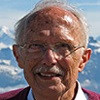5.7.3: Forecasts Instead of Predictions (The Parkfield Experiment)
- Page ID
- 6000
Overview
A more sophisticated but more modest forecast was made by the USGS for the San Andreas Fault at Parkfield, California, a backcountry village in the Central Coast Ranges. Before proceeding, we must distinguish between the term prediction, such as that made by Brady for Peru, in which it is proposed that an earthquake of a specified magnitude will strike a specific region in a restricted time window (hours, days, or weeks), and the term forecast, in which a specific area is identified as having a higher statistical chance of an earthquake in a time window measured in months or years. Viewed in this way, the USGS made a forecast, not a prediction, at Parkfield.
Parkfield had been struck by earthquakes of M 5.5 to 6.5 in 1901, 1922, 1934, and 1966, and newspaper reports suggested earlier earthquakes in the same vicinity in 1857 and 1881. These earthquakes came with surprising regularity every twenty-two years, give or take a couple of years, except for 1934, which struck ten years early. The 1966 earthquake arrived not twenty-two but thirty-two years later, resuming the schedule followed by the 1922 and earlier earthquakes. The proximity of Parkfield to seismographs that had been operated for many years by the University of California, Berkeley, led to the interpretation that the last three earthquake epicenters were in nearly the same spot. Furthermore, foreshocks prior to the 1966 event were similar in pattern to foreshocks recorded before the 1934 earthquake.
Scientists at the USGS viewed Parkfield as a golden opportunity to “capture” the next earthquake with a sophisticated, state-of-the-art array of instruments. These instruments were installed to detect very small earthquakes, changes in crustal strain, changes of water level in nearby monitored wells, and changes in the Earth’s magnetic and electrical fields. The strategy was that detection of these subtle changes in the Earth’s crust might lead to a short-term prediction and aid in forecasting larger earthquakes in more heavily populated regions.
At the urging of the California Office of Emergency Services, the USGS took an additional step by issuing an earthquake forecast for Parkfield. In 1984, it was proposed that there was a 95 percent chance, or probability, that an earthquake of a magnitude similar to the earlier ones would strike Parkfield sometime in the period 1987 to 1993. A system of alerts was established whereby civil authorities would be notified in advance of an earthquake. Parkfield became a natural laboratory test site where a false alarm would not have the social impact of a forecast in, say, San Francisco or Los Angeles.
The year 1988, the twenty-second anniversary of the 1966 shock, came and went with no earthquake. The next five years passed; still no earthquake. By January 1993, when the earthquake had still not occurred, the forecast was sort of, but not exactly, a failure. The 5 percent probability that there wouldn’t be an earthquake won out over the 95 percent probability that there would be one.
The Parkfield forecast experiment is like a man waiting for a bus that is due at noon. Noon comes and goes, then ten minutes past noon, then twenty past. No bus. The man looks down the street and figures that the bus will arrive at any minute. The longer he waits, the more likely the bus will show up. In earthquake forecasting, this is called a time-predictable model: the earthquake will follow a schedule, like a bus.
But there is another view: that the longer the man waits, the less likely the bus will arrive. Why? The bus has had an accident, or a bridge collapsed somewhere on the bus route. The “accident” for Parkfield might have been an earthquake of M 6.7 in 1983, east of Parkfield, away from the San Andreas Fault, near the oil-field town of Coalinga in the San Joaquin Valley. The Coalinga Earthquake may have redistributed the stresses building up on the San Andreas Fault to disrupt the twenty-two-year earthquake “schedule” at Parkfield.


